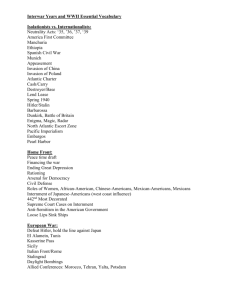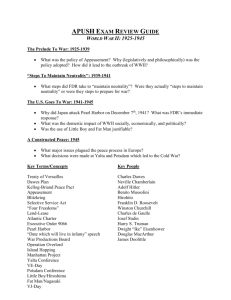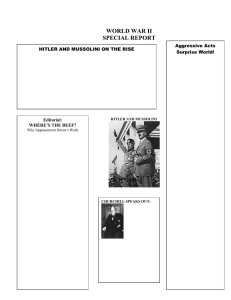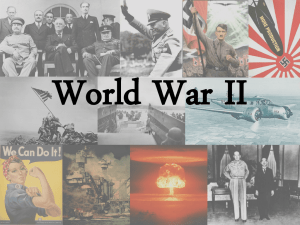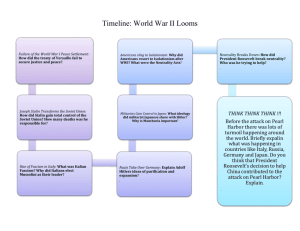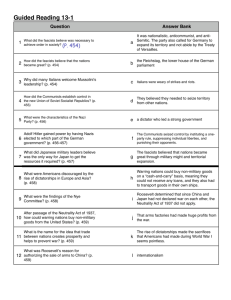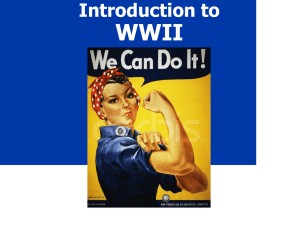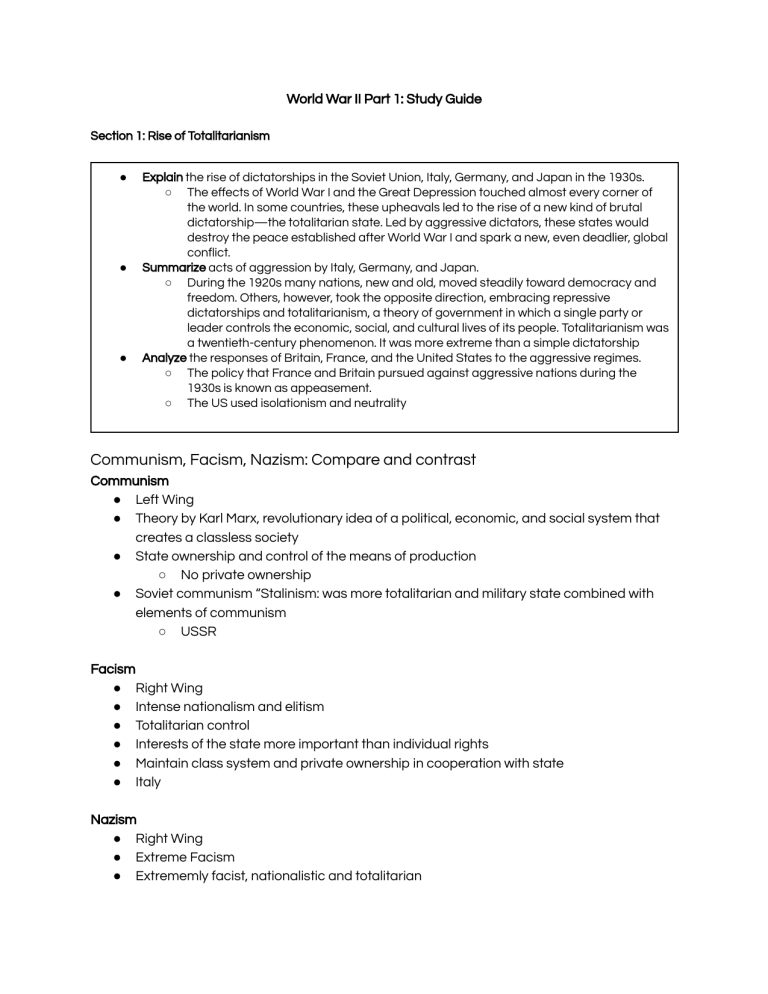
World War II Part 1: Study Guide Section 1: Rise of Totalitarianism ● ● ● Explain the rise of dictatorships in the Soviet Union, Italy, Germany, and Japan in the 1930s. ○ The effects of World War I and the Great Depression touched almost every corner of the world. In some countries, these upheavals led to the rise of a new kind of brutal dictatorship—the totalitarian state. Led by aggressive dictators, these states would destroy the peace established after World War I and spark a new, even deadlier, global conflict. Summarize acts of aggression by Italy, Germany, and Japan. ○ During the 1920s many nations, new and old, moved steadily toward democracy and freedom. Others, however, took the opposite direction, embracing repressive dictatorships and totalitarianism, a theory of government in which a single party or leader controls the economic, social, and cultural lives of its people. Totalitarianism was a twentieth-century phenomenon. It was more extreme than a simple dictatorship Analyze the responses of Britain, France, and the United States to the aggressive regimes. ○ The policy that France and Britain pursued against aggressive nations during the 1930s is known as appeasement. ○ The US used isolationism and neutrality Communism, Facism, Nazism: Compare and contrast Communism ● Left Wing ● Theory by Karl Marx, revolutionary idea of a political, economic, and social system that creates a classless society ● State ownership and control of the means of production ○ No private ownership ● Soviet communism “Stalinism: was more totalitarian and military state combined with elements of communism ○ USSR Facism ● Right Wing ● Intense nationalism and elitism ● Totalitarian control ● Interests of the state more important than individual rights ● Maintain class system and private ownership in cooperation with state ● Italy Nazism ● Right Wing ● Extreme Facism ● Extrememly facist, nationalistic and totalitarian ● ● Based on beliefs of the national socialist german workers party Belief in the racial superiority of the aryan, master race ○ White, blond hair, blue eyed germans ○ Germany Kellogg-Briand Pact: What was it, to what extent was it used and who violated The Kellogg–Briand Pact is a 1928 international agreement in which signatory states promised not to use war to resolve “disputes or conflicts of whatever nature or of whatever origin they may be, which may arise among them.” Parties failing to abide by this promise “should be denied of the benefits furnished by this treaty.” It was signed by Germany, France, and the United States on August 27, 1928, and by most other nations soon after. Sponsored by France and the U.S., the Pact renounces the use of war and calls for the peaceful settlement of disputes. Similar provisions were incorporated into the Charter of the United Nations and other treaties and it became a stepping-stone to a more activist American policy. The treaty was put to the test and failed in 1931 when Japan invaded Manchuria, China. It became clear that the Kellogg-Briand Pact proved ineffective in preventing war without enforcement and with undefined legal terms. World War II began just 11 years after its signing. Reasons for the rise of totalitarian regimes - Economic Issues - Inflation War Political Unrest Government problems - Corruption People feel unheard by the government and want to be united Controlling what media the people are exposed to What children are taught in school Rise of Totalitarian Regimes ● Cult of personality ○ Promising to lift nation out of a crisis ○ Make leaders god-like ● Civil rights ○ Individuals not as important as state ○ Rights stripped away ● Militarism ○ War unites a nation ● Propaganda ● Youth indoctrination ○ Embedded obedience, racism, militarism, nationalism in youth ■ Hitler youth a system of government based upon a single dictator who has absolute power, it is strict and there are typically many rules, people must demonstrate loyalty as well as other aspects. Early Acts of aggression by Japan and Germany Japan and US Relations ● War in the pacific was especially important because between Hawaii and Japan, there were many US territories that were especially crucial because they were bases/stopping points for planes between the US and Japan, China and other countries around that area. ● Japan wants power, space and more resources ○ There population is increasing significantly, they want more land to expand onto ● By June 1942, Japan's sphere of influence stops growing as US island hopping occurs and begins to shut it down Early Events of the War (Japan) ● Japan’s economy was in ruins, they depended on selling goods to foreign nations ○ Nations put high tariffs on their goods ● Democracy’s slow process to blame ● Rise of nationalism ● Radicals support military take over ● Growing population → manchurian incident → first to break kellogg briand pact ○ The manchurian incident showed Japan’s power for the first time, defeat the soviets ● Tensions escalate to full scale war with china ○ Everyone was in china ● Wanted “oil rich: dutch east indies ● Goal: Supremacy to asia and the larger world stage ● U.S. places trade embargos and cuts off resources to Japan ○ US attempts to show neutrality ○ This then leads to pearl harbor Section 2: America Getting Involved ● ● ● ● Describe Franklin Roosevelt’s foreign policy in the mid-1930s and the great debate between interventionists and isolationists. ○ FDR stuck with an isolationist policy but there was still great debate about joining WW1 ○ Interventionists wanted to join the war and help fight it, FDR became a interventionist ○ Isolationists wanted to stay out of the war, this went on until pearl harbor Explain how the United States became more involved in the conflict. ○ Lend Lease act and the bombing of pearl harbor Explain why Japan decided to attack Pearl Harbor, and describe the attack itself. ○ They were upset because America stopped trading oil and overall stopped trading to them and they needed the natural resources. ○ Pearl Harbor was a horrible attack on a naval base in Hawaii by planes that dropped bombs on them ○ Dec 7, 1943 Outline how the United States mobilized for war after the attack on Pearl Harbor. ○ They instantly declared war on japan and germany on dec 7th ○ War efforts began ○ All races joined the fight Early Approaches to war and their effectiveness: Isolationism, Appeasement, Neutrality, Intervention Isolationism ● Neutrality act: prohibited the sale of arms or making loans to warring countries ● Roosevelt needed the support of isolationism in congress, they wanted to remain neutral but he did not ● The US didn’t want to intervene in the Spanish Civil War on the Japanese invasion of China Intervention ● When italy invaded Ethiopia, Roosevelt stopped arms sales to both countries which only hurt Italy ● Roosevelt did not want to remain neutral - he was worried about the aggressive actions of the totalitarian leaders ● Roosevelt began to speak out against neutrality with his quarantine speech ● Neutrality officially ended with Pearl Harbor Appeasement ● ● Appeasement is the act of giving into aggressive demands in order to maintain peace. British Prime Minister Neville Chamberlain used appeasement to give into Hitler's demands of taking over Czechoslovakia in exchange for peace at the Munich Conference. ○ ● This was frowned upon by Winston Churchill openly especially since Hitler failed to stop and adhere to his agreements. Significance: The appeasement displayed by others (British and French) gave Hitler more confidence in his military actions causing WW2 after Hitler had broken the treaty of Versailles to build up his forces and conquer lands on multiple occasions. The largest act of appeasement was the League of Nations allowing Hitler to get part of the Czech territory. However , this was not enough and he continued to take over the rest of the territory. Neutrality Acts ● ● ● 1st Neutrality Act 1935 ○ Prohibiting the export of arms, ammunition and implements of bar ○ Prohibit americans from lending loans to belligerent nations 2nd Neutrality Act 1937 ○ US citizens prevented from traveling on belligerent ships and prohibited American ships from transporting arms ■ Even if not made by the us ○ bar all belligerent ships from US waters ○ Did allow cash and carry - US could provide vital materials as long as they paid immediately and shipped themselves 3rd Neutrality Act of 1939 ○ America extends cash and carry to arm sales ■ US begins aiding allies under the lend lease act: loaning googs to friendly countries while still remaining neutral ● Britain Lend-Lease Act Passed on March 11, 1941, this act set up a system that would allow the United States to lend or lease war supplies to any nation deemed "vital to the defense of the United States." In July 1940, after Britain had sustained the loss of 11 destroyers to the German Navy over a 10-day period, newly elected British Prime Minister Winston Churchill requested help from President Roosevelt. Roosevelt responded by exchanging 50 destroyers for 99-year leases on British bases in the Caribbean and Newfoundland. As a result, a major foreign policy debate erupted over whether the United States should aid Great Britain or maintain strict neutrality. Reasons for the outbreak of WWII Section 3:Early Events of the War ● Explain the island hopping technique and how it helped the Americans during the war. ○ Leapfrogging would allow U.S. forces to reach Japan more quickly and not expend the time, manpower, and supplies to capture every Japanese-held island on the way. It would also give the Allies the advantage of surprise and keep the Japanese off balance. ● Analyze the importance of the Battle of Midway and America's position in the war ○ Turning point of WWII in the Pacific, in which the Japanese advance was stopped ○ ● US Victory and the turning point in the war in the pacific, America finally got the upper hand Describe life for Japanese Americans during World War II ○ While living in overcrowded conditions behind barbed wires, these Americans attempted to bring normalcy to their lives, they created newspapers, schools, markets, police forces, and fire fighting squads. While their families were confined, more than 33,000 Japanese Americans played a major role in the war effort. ● Explain the significance of Operation Barbarossa Militarism a political orientation of a people or a government to maintain a strong military force and to be prepared to use it aggressively to defend or promote national interests At the start of the war, the US was not involved, so their expenditures on the military were incredibly low. However by 1943, after they joined the war, their expenses skyrocketed because they were fighting. It is possible their expenses are especially high because they are so geographically isolated from the other countries. Japanese Internment The US put all Japanese people in internment camps because they were afraid of espionage, most Japanese people were immigrants and most lived on the west coast. They lived in horrible conditions and were treated like animals. However, the work they did, did contribute to the war efforts of America. Operation Barbarossa War Breaks out In Europe ● Spring 1930 hitler violates munich pact and absorbed the rest of czechoslovakia (appeasement fails ● ● ● ● ● ○ Germany makes pact to take poland with soviet union to free up the army in the west Poland falls to germany sept 1939 Operation barbarossa - hitler invades soviet union in june 1941 ○ Operation Barbarossa, original name Operation Fritz, during World War II, code name for the German invasion of the Soviet Union, which was launched on June 22, 1941. The failure of German troops to defeat Soviet forces in the campaign signaled a crucial turning point in the war. ○ Although Adolf Hitler had congratulated himself on the German-Soviet Nonaggression Pact of 1939 as a matter of expediency, anti-bolshevism had remained his most profound emotional conviction as World War II entered its second year. Axis powers (germany, Italy, japan) overwhelm western Europe, allied powers (US, france, canada, britain, soviet union) France falls to germany may 1940 Island Hopping ● Leapfrogging would allow U.S. forces to reach Japan more quickly and not expend the time, manpower, and supplies to capture every Japanese-held island on the way. It would also give the Allies the advantage of surprise and keep the Japanese off balance. ● Leapfrogging was a military strategy that entailed bypassing and isolating heavily fortified Japanese positions while preparing to take over strategically important islands. It originated from island hopping. ● Island hopping entailed taking over an island and establishing a military base there. The base was in turn used as a launching point for the attack and takeover of another island. ● Leapfrogging: A military strategy employed by the Allies in the Pacific War against the Axis powers (most notably Japan) during World War II. It entailed bypassing and isolating heavily fortified Japanese positions while preparing to take over strategically important islands. ● Island hopping: A military strategy employed by the Allies in the Pacific War against the Axis powers (most notably Japan) during World War II. It entailed taking over an island and establishing a military base there. The base was in turn used as a launching point for the attack and takeover of another island. BIG QUESTION What caused ww2? ● The rise of totalitarian regimes ○ People were promised change and new beginnings ○ Germany was struggling after the debts of WW1 when Hitler came into power ■ They were promised a better future and new opportunities ○ Political Unrest ○ Economic problems ● Japan wanting more ○ They wanted more land to expand onto ○ They needed more natural resources ■ Specifically from america ● Appeasement ○ Attempt to appease Hitler by giving him czechoslovakia, but it gives him more power ● Isolationism/Neutrality ○ The US staying out of the war and neutral was overall working ○ However, Japan got upset because of the trade embargos ○ The neutrality acts kept them from intervening ○ But, they did participate in the lend lease acts which was not really considered being neutral ● Rise of militarism in japan and germany
